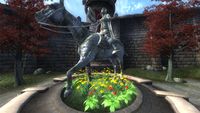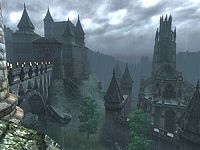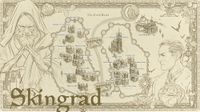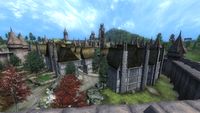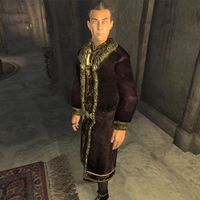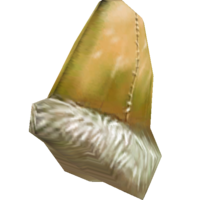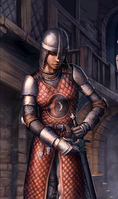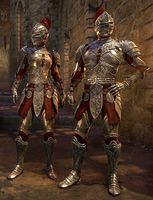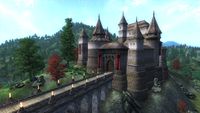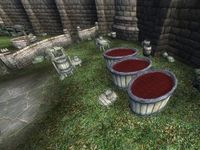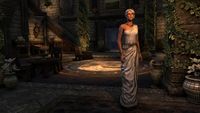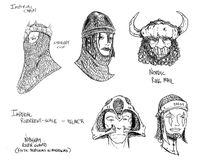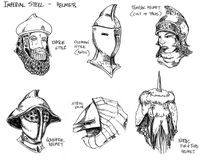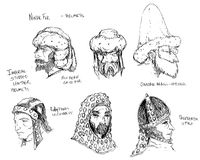Lore:Skingrad
| Skingrad | |
|---|---|
| Type | Settlement |
| Continent | Tamriel |
| Province | Cyrodiil |
| Region | West Weald |
| Appears in | Oblivion, ESO |
Skingrad is a Colovian town located in the West Weald region of Colovia, to the southwest of the Imperial City, along the Gold Road. Through this road, it is connected to Kvatch and Sutch. Skingrad is known as the Gem of Old Colovia, and a model of the Colovian virtues of independence, hard work, and tough-mindedness.[1] The town is particularly famous for its wines, tomatoes, and cheeses, which contributes to its overall prosperity. Under the leadership of Count Janus Hassildor, thievery, crime, gambling, and public drunkenness were almost unknown in Skingrad.[1] Famous wine makers in Cyrodiil such as the Surilie brothers and Tamika resided here.[2] The renowned tailor Diocletia Orbus of Skingrad, whose clothing was popular among nobles from all around Cyrodiil, also hailed from the city.[3] The Colovian nobility, who often make up officers of the Imperial Legions or its West Navy, prefer immaculate uniforms with stark standards that match their rough cliffside fortresses, and scorn the costly expenditures of courtly life seen in Nibenay.[4]
Historically, at the time of the Alessian Reformation, the Westerners were in a firm position to resist its doctrines, thanks to their culture and location. The pantheon of Eight Divines survived unchecked in Western Cyrodiil, and relations with the increasingly Alessian East became strained.[4] Rislav Larich was notably at the forefront of protecting Skingrad from the Marukhtis and ensuring Skingrad's independence.[5] Ultimately, the West isolated itself from the theocratic hegemony of the Nibenay Valley, establishing an autonomous government, the Colovian Estates. Colovians are uncomplicated, self-sufficient, hearty, and extremely loyal to one another. At times where the east became weak from lack of strong leadership, the Colovians would withdraw unto themselves in the belief they were keeping the national spirit safe until a proper Emperor came to rule. The Colovian Estates began to overshadow the richer, more populous East then, which eventually lead to the War of Righteousness that ended Alessian rule.[4]
Contents
Layout & Geography[edit]
|
The town divides into three districts: the Castle, Hightown, and Chapel, with various gates and bridges connecting each district. The town is further divided in two parts: the north wall encompasses the business district and the guild halls, while the southern half holds homes and the Great Chapel of Julianos, where citizens and travelers can pray for healing. Outside of town is the castle of Janus Hassildor, count of Skingrad and wizard,[1] who is reportedly a vampire, a fact known to and kept as a secret by the Mages Guild.[6]
History[edit]
First Era[edit]
The area that would later become known as Skingrad was originally inhabited by Ayleids who were speculated to have worshipped a Daedric Prince with unknown iconography. There was also humans that were most likely Nedic people that called the settlement home around this time.[7] Skingrad's origins have ancient roots that stretch back to the Cyro-Nords, who, seeking to distance themselves from the use of magic or the need for industry in the Nibenay, headed to the west to conquer the frontier that was Colovia.[4] Skingrad was built by worshippers of the Aedric God of Wisdom and Logic, who erected the Great Chapel of Julianos upon the venerated grounds of the Ayleids who were banished from there following the Alessian Slave Rebellion.[8][7] Skingrad was established as an independent kingdom, but it still owed its allegiance to the White Gold Tower. Skingrad along with Anvil, Chorrol, and Kvatch, created the autonomous government known as the Colovian Estates, which resisted the Alessian Order's rising influence.[7]
Rislav Larich was a King of Skingrad in ancient times.[5] Born in 1E 448 to Queen Lynada, who died shortly after giving birth, and King Mhorus of Skingrad, Rislav had three older brothers and four older sisters. In 472, the skirmishing between Skingrad and Kvatch ended, apparently due to the marriage of Prince Rislav and Belene, the daughter of King Justinius of Kvatch.[5]
A plague in 1E 478 took the lives of the royal family in Skingrad, sparing the lives of Rislav and his older brother Dorald, who was a priest of Marukh living in the Imperial City. Dorald returned to Skingrad and took the throne, his first edict being to give over the kingdom to the Empire. This prompted a battle between Dorald and Rislav, in which Rislav slew Dorald and became the new King of Skingrad. After withdrawing the offer of Skingrad to the Empire, Skingrad faced the Alessian army in their conquest in many battles, defeating them finally after joining forces with Kvatch and The Kings of the Colovian West to end the Alessian hegemony. King Rislav's glory is currently showcased as a romanticized statue in Hightown.[5]
Circa 1E 2319, the Alessian Order attempted to intervene in the arranged marriage between the children of King Desynan of Skingrad and Queen Margert Gardner of Wayrest. Fearing a dynastic alliance between High Rock and Colovia, Arch-Prelate Zirnius who forbid the union, sent out his legions to punish the Colovians after Desynan circumvented Zirnius' ruling by appointing someone to officialize this marriage. This conflict was initially "anarchy, local uprisings, and shifting alliances" that were contained within the Colovian Estates, but it later shifted to Breton lands within the Iliac Bay.[9] The Legions of Piety and Grace were sent to Bangkorai under Abbot-General Priscus Mactator to suppress the Bretons, but the Imperials fell at the Bangkorai Garrison.[10] This loss would embolden the rebelling Colovians, officially kickstarting the War of Righteousness in 1E 2321,[11] which would ultimately result in the dissolution of the Alessian Order.[9][4] The war officially ended with the arrangement of a puppet Emperor to Skingrad.[9][nb 1]
Disinterested in matters of state, Emperor Brazollus Dor spent most of his reign at his country estate near Skingrad, preferring to let his Potentate Sidri-Ashak run almost all of the Empire's affairs in the many years leading up to his death in 1E 2877.[12]
Second Era[edit]
With Colovia's prosperity for most of the Second Era, wine and cheese production motifs would populate the overland.[13] Skingrad also became known as a city of immigrants where people of various skill sets are welcome,[14] and some of the immigrants from other provinces brought their own wine-making techniques and recipes to the area. The vineyards around Skingrad are responsible for some of the West Weald's best wines. Some of the ingredients introduced during this time to Skingrad's wines were lavender, lotus, comberries, and ginger.[15] The Great Chapel of Julianos and its school by this point in time had become a major contributing factor to the traffic of philosophers and other kinds of intellectuals coming into Skingrad. Visitors from various provinces make their way to the city's chapel or nearby taverns to participate in civil debates, which is due to the Julianos faithful being open-minded.[8]
The Surilie family are Bretonic vintners that would not establish themselves within Skingrad until the future, though their creations did have a presence in the region by the time of the Three Banners War.[UOL 1] Originating from the family itself, Surilie recipes and grapes[UOL 1] saw use throughout Tamriel during this time period.[16] Surilie Grapes were grown in bountiful harvests in the West Weald along with other kinds of grape variants. Surilie Grapes were utilized in the Weast Weald within the Skingrad Muscat and Weald Wallop recipes, the latter recipe which made the region famous among wine lovers.[15][16]
Arcturus Vano was imprisoned sometime around the Planemeld for assassinating the Alderman of Skingrad.[17] Count Calantius of Skingrad was a canny opportunist who kept his city just out of the chaos of warfare engulfing most of Cyrodiil during the Three Banners War, but still ruled a military-minded people, being quite ambitious himself.[18] Taking advantage of this power vacuum, he sent a legion of mercenaries to plunder or even annex the border city of Arenthia in 2E 582.[19][20] General Lavinia, leader of the Legion of the West Weald, attempted to annex the "South Weald" for the Empire of Cyrodiil, but was thwarted by resistances working with the Aldmeri Dominion.[21][22]
Circa 2E 582, Skingrad and the rest of the West Weald was threatened by the Dawnwood, which saw Valenwood's jungles encroaching into the region overnight. Accompanying this was the Wildburn, a magical sickness separating the West Weald and the Dawnwood, which corrupted the area and the native creatures of the land.[23] The region was under attack by Bosmeri Ayleid revivalists known as the Recollection, who in their eyes, saw to bring reclaim the lands of their ancestors. They allied themselves with the forces of the forgotten Daedric Prince Ithelia, but they were thwarted. Afterwards, Count Calantius negotiated a treaty with Bosmer settlement of Vashabar, who migrated into the West Weald areas claimed by the Dawnwood.[citation needed]
Third Era[edit]
By the late Third Era, the Surilies had established themselves as prominent vintners within Skingrad. The Surilie Brothers Winery had a friendly rivalry with the Tamika Winery.[2] When asked if the wine from the Surilie or the Tamika Vineyards are better, Skingrad's citizens say that Tamika's is "every bit as good as the Surilie Brothers wines".[24] However, Davide Surilie believed his creations were not as good as Tamika's wine but were more affordable.[2]
In 3E 227, Daravyn the Gray, an escaped prisoner from the Imperial City Prison, hid the Ring of the Gray in Rosethorn Hall before being recaptured by the local guard.[25]
Nearing the end of the Five Year War, captive legionnaires held by the Bosmer were released and traveled to Skingrad to report and regroup.[26][UOL 2]
Circa 3E 433, Skingrad was ruled by Count Janus Hassildor, who had already been ruling for many years due to the prolonged unlife granted to him by his vampirism.[1][27] Hassildor was widely honored and respected by his people, and during his reign, Skingrad was considered a well-run, orderly county.[1] During the Oblivion Crisis, Skingrad faced a threat to its existence when an Oblivion Gate appeared outside the city. It was closed by the Hero of Kvatch, and as thanks, Janus sent troops to aid in closing the Great Gate that was subsequently opened at Bruma.[27][28]
Fourth Era[edit]
An insurgent faction active in 4E 48 known as the Natives was from County Skingrad. They utilized distinctive arrows and often beheaded the bodies of the people they killed.[29] Over fifty years after the Oblivion Crisis, Sinderion, an Altmer alchemist, bought a rare sample of crimson nirnroot in the city before heading to Skyrim.[30]
During The Battle of the Red Ring in 4E 175, General Jonna's troops faced bitter resistance as the Aldmeri counterattacked from Bravil and Skingrad. The heroic Nord legionnaires held firm, however, beating off the piecemeal Aldmeri attacks. By the fifth day of the battle, the Aldmeri army in the Imperial City was surrounded.[31]
The apprentice of Balagog gro-Nolob, Urzhag gro-Larak, visited Skingrad circa 4E 197. He entered a luxury cuisine competition and beat his competitors, who had better cooking equipment than him but lacked the experience. His reward was a set of intricate silver cookware, which he gifted to a hospitable local innkeeper named Emeloria. She later sold them and used the funds to fix up her inn.[32]
The Surilie Brothers Vineyard at Skingrad was still active into the third century of the Fourth Era, where clientele would drink within its boundaries.[33]
Known Rulers[edit]
- First Era
- Second Era
- Countess Ornelda Calvus (ca. 2E 107)[34]
- Count Calantius (ca. 2E 582)
- Third Era
- Count Janus Hassildor (ca. 3E 433)
Gallery[edit]
Notes[edit]
- According to Castles, the "Skingrad United" arena team competed in an event known as the Dragon Games.[35]
See Also[edit]
- For game-specific information, see the Oblivion and Elder Scrolls Online
 articles.
articles.
Books[edit]
- An Abbreviated History of Skingrad by Antonious Civello, University of Gwylim Press — A short history of the city of Skingrad
- Guide to Skingrad by Alessia Ottus — An overview of Skingrad's people and notable places
- Rislav The Righteous by Sinjin — Heroic tales of Rislav Larich, ancient King of Skingrad
References[edit]
- ^ a b c d e Guide to Skingrad — Alessia Ottus
- ^ a b c Davide Surilie's dialogue in Oblivion
- ^ Diocletia's Pattern Book, Autographed
- ^ a b c d e Pocket Guide to the Empire, 1st Edition: Cyrodiil — Imperial Geographical Society, 2E 864
- ^ a b c d e f g Rislav The Righteous — Sinjin
- ^ Raminus Polus' dialogue in Oblivion
- ^ a b c An Abbreviated History of Skingrad — Antonious Civello, University of Gwylim Press
- ^ a b The Shield of Julianos — Father Haderus Donton
- ^ a b c d On the War of Righteousness — Valenca Arvina, Historian-in-Residence at Gwylim University
- ^ Bangkorai, Shield of High Rock — King Eamond
- ^ Systres History: Volume 4 — Trilam Heladren, Associate Dean of Eltheric History, University of Gwylim
- ^ High King Emeric Answers Your Questions — High King Emeric
- ^ Gold Road Preview—Designing Ithelia & Gold Road from the official ESO website
- ^ Berwadira's dialogue in ESO
- ^ a b Wines of West Weald — Orius Hertano
- ^ a b Surilie Grapes acquisition method and related recipes in ESO
- ^ Demands of the Painted Eye
- ^ Special ZOS Lore Master Interview with Lawrence Schick
- ^ Yours for the Taking! — Catonius Libo, Aide-de-Camp to General Lavinia Axius
- ^ Cohort Briefing: Arenthia — Centurion Iunius Ocella
- ^ The Colovian Occupation quest in ESO
- ^ Stonefire Machinations quest in ESO
- ^ ESO 2024 Global Reveal
- ^ Skingrad Rumors in Oblivion
- ^ Long Forgotten Note — Daravyn the Gray
- ^ Mixed Unit Tactics — Codus Callonus
- ^ a b Janus Hassildor's dialogue in Oblivion
- ^ Allies for Bruma quest in Oblivion
- ^ The Infernal City — Greg Keyes
- ^ Sinderion's Field Journal — Sinderion
- ^ The Great War — Legate Justianus Quintius
- ^ The Elder Scrolls: The Official Cookbook Vol. 2 — Erin Kwong, Victoria Rosenthal
- ^ Please Read Aloud
- ^ Fresco, Colovian Lady antiquity entries
- ^ Gladiatorial Glory event in Castles
Note: The following references are considered to be unofficial sources. They are included to round off this article and may not be authoritative or conclusive.


